#parallels abound
Explore tagged Tumblr posts
Text
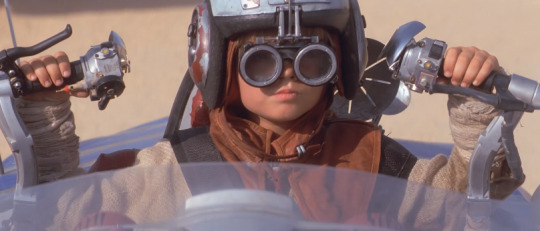
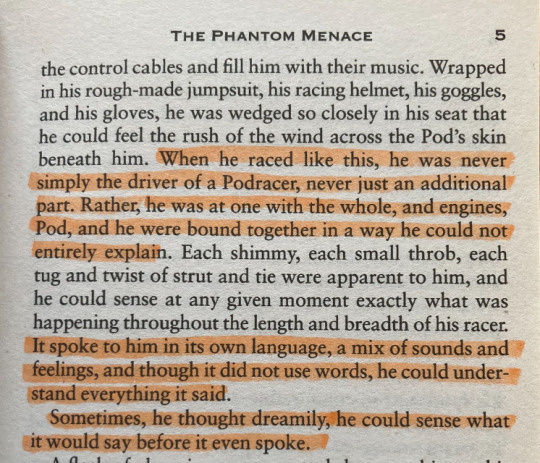

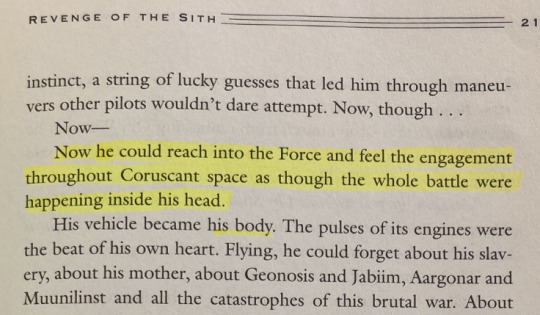
anakin's unparalleled ability to become his vehicle, to extend his awareness beyond himself and mesh into the machinery, disappearing into the environment of the race, the battle, and reacting with superhuman unconscious skill and reflex—it's been with him since he was a small boy, and continued well into his adulthood. it's a fundamental part of who he is and how he interacts with the force, the context in which he excels beyond any other human. he doesn't have to reason, doesn't have space to even think, he's bigger than himself and transcends himself. qui-gon told him to feel, not to think, to trust his instincts, and this is the only time when that advice is completely valid. when anakin is a pilot, he can forget about all his pain and fear. he can be really free to lose himself, and become the best version of himself at the same time.
#anakin skywalker#infinitely beloved#his best self behind the control of a ship#terry brooks' phantom menace and matthew stover's revenge of the sith#parallels abound#sw
275 notes
·
View notes
Text
watching daredevil while reading kafka’s the trial in english is like just how much can we ponder catholicism’s effect on justice and morality systems
anyways matt murdock my beloved but he is sometimes a dumbass and josef k. my beloathed why are you the way that you are
#ik neither is just about catholicism also#parallels abound#i just find it silly#in a soul-searching how-society-works-and-inevitably-fails kinda way#also everyone in the fandom is down bad for this man. like i get it but. no actually i just get it#leo says stuff#actual posting era??? mayhaps#daredevil#kafka the trial
4 notes
·
View notes
Text
Seeing the flashbacks in 7x08 sheds so much light on Bobby's reaction to certain events during the show.
Why Bobby treated Buck the way he did after the embolism and the lightning strike. It's so much more than just being an overprotective parental figure.
The first time was this fear that Buck was in front of him, coughing up blood and dying. He couldn't save his father from dying, but he sure as hell could try and save Buck. And do everything in his power to make sure he remains safe and out of danger.
And then Buck dies after being struck by lightning. He sits vigil at his bedside when he knows there's a chance that Buck will pull through. And he comes back. So, of course, this time, he treats him differently; of course, he overcorrects and gives him slack in his performance review. Of course, he's gentler with him, Buck woke up. And his father didn't.
Their relationship is so complicated in that Bobby views Buck as his son, but he's also been this trigger for the trauma he experienced with his father.
What happened with his father also reinforces why Bobby struggled so much with being unable to sus out Jonah. Bobby put on his headphones and didn't notice what was happening in his house.
#911 on abc#911 spoilers#911#911 abc#bobby nash#evan buck buckely#all this to say really that this was one of my favourite episodes of this season#The parallels abound#and it makes the Bobby and Buck dynamic that much more intense and complicated and good#I also would love to see Bobby being able to give Eddie more advice in the future about the ones you cannot save#and how you cannot use people to fix your guilt over the losses you've suffered and things you wish you did differently
239 notes
·
View notes
Text
sorry going back to this people don't understand how fucked gaslighting is and generally downplaying the impact of psychological abuse. but think about how isolated Louis is. think about how long it's just been the two of them. think about how Armand fosters a paternalistic "protective" environment for Louis (his "prison of empathy") and how the one time we see Louis try and access emotional support outside of Armand pre-Dubai (making a connection with Daniel, speaking about Lestat and Claudia, two big no no zones for Louis and Armands relationship) he is brutally punished. Think about how Louis can't trust his own mind, how he needs Daniel (just like he needed Claudia with Lestat) to help make sense of his story. Like... how must that feel? To be trapped in a cage, being told it's for your own good and believing it. Internalizing the victim blaming (apologizing to Armand for his attempt, "I don't consider myself abused") because to realise after so many years together, a relationship predicated on running away from a past abusive relationship, that it is the same would be for it all to crumble. Which is why the finale is so powerful -- it's Louis taking back control.
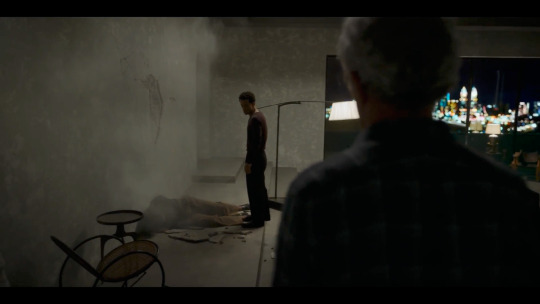
basically . can we talk about this shot.
#iwtv#loumand#louis de pointe du lac#sry this is a rambly mess#and this is not even factoring in the reveal that armand actually directed the play.#the note about the hoarding?#armand is constantly framing louis as a hysterical woman 😭#< s1 and s2 parallels abound. i love this show#my text
47 notes
·
View notes
Text
Personally I want Garp to break out with Pudding and punch Blackbeard as hard as he can as a last Fuck You before he can finally keel over but maybe that's just me
#old man we gotta make use of what remaining power ya have to get Pudding OUTTA there#or at least that's where I think the plots headed#it's either that or Kuzan being undercover is still something thats on the table#monkey d. garp#opspoilers#one piece spoilers#one piece ch 1126#opspoiler#Another thought I had was Blackbeard using Garp to lure out Luffy as some sick parallel to Marineford which is. lol. fun 💀#speculations abound
15 notes
·
View notes
Text
I like Eowyn, Eomer and Faramir now too.
Bring on the protective, slightly patronizing brother-sister dynamic. So anime.
Bring on the mutual healing and romance in a hospital ward. Not sure if that’s anime but it’s still one of my favorite things.
#parallels to flowers of Mordor abound as well#lotr#lord of the rings#lanespoiler#faramir x eowyn#eowyn#Faramir#eomer#crossover#anime#flowers of mordor au
3 notes
·
View notes
Text
Gurathin's "Do you have feelings for it?" really adds another layer to his dislike of SecUnit.
Though the whole group is still grappling with whether to trust it or not, Gurathin remains the most stubbornly vocal about that distrust and on one level we already understood why. He's a former member of the Corporation Rim, someone who both grew up on the same feeds as the SecUnit engineers—'They go rogue and kill everyone all the time!'—and, as we learn this episode, has been horrendously abused by the Company itself, so why would he trust anything it gave them? One might even go so far as to say Gurathin still doesn't see SecUnit as a person, only a very dangerous piece of equipment.
Except... you don't see equipment as a romantic rival.
We know Gurathin has a rather intense crush on Mensah and who can blame him? She not only forgave him when few others would have, but she turned his whole world on its head, providing him with a new purpose and autonomy and love when he was very close to giving up. That's the level of devotion that inspires sneaking into her bedroom to smell her pillow, or staring star-struck across the dinner table, unable to think of a single critique. Gurathin loves Mensah and Mensah obviously loves him... but not in the same way.
Now toss SecUnit into the mix. Here's Company property that scares the shit out of you and as if that weren't enough, the woman you love is being so nice to it. Not just that, she's seemingly prioritizing it over you.
"It feel like it's going through something" vs. I'm going through something.
Running to talk to SecUnit vs. I was the one who was just threatened.
"I feel we can trust it" vs. I thought you trusted me?
"You need a MedBay" vs. But you won't get me to one because SecUnit advises otherwise, right? (Notably, Gurathin doesn't seem to be conscious when Mensah makes the decision to leave anyway, with or without SecUnit).
There are a lot of other moments like this and from our perspective we can see that Mensah is treating SecUnit similarly to how she no doubt treated Gurathin six years ago. The parallels between them abound, including being slaves to the Company who only start to demonstrate true autonomy after meeting Mensah. Gurathin still has a lot of healing to do, but after so many years he's in a better place than the slave that has just admitted to some level of personhood (not to mention the practical issues of them needing SecUnit to defend them), so of course Mensah is going to prioritize it to a certain extent. She's trying to help it the way she once helped Gurathin, but Gurathin is still so damaged and so JEALOUS that he can't conceptualize, "Oh. She's giving SecUnit what I was once lucky enough to receive."
He can't see that, so what comes out instead is, 'You have feelings for it don't you?' Because what other explanation does he have? If SecUnit already 'stole' her attention and her high opinion, why not her romantic love too! I don't think Gurathin would have ever asked that without the fever lowering his inhibitions, but I don't think the fever caused that worry either.
Gurathin makes me insane because I just want to scream, "SecUnit is you! It's you! It's not your rival, it's a mirror of who you were six years ago! You're not in competition with it, you're the best person to help it because you know something of what it's gone through!! You get to pass the torch, Gura, and help Mensah help someone else!!!!"
408 notes
·
View notes
Text

For the past six years or so, this graph has been making its rounds on social media, always reappearing at conveniently timed moments…
The insinuation is loud and clear: parallels abound between 18th-century France and 21st-century USA. Cue the alarm bells—revolution is imminent! The 10% should panic, and ordinary folk should stock up on non-perishables and, of course, toilet paper, because it wouldn’t be a proper crisis without that particular frenzy. You know the drill.

Well, unfortunately, I have zero interest in commenting on the political implications or the parallels this graph is trying to make with today’s world. I have precisely zero interest in discussing modern-day politics here. And I also have zero interest in addressing the bottom graph.
This is not going to be one of those "the [insert random group of people] à la lanterne” (1) kind of posts. If you’re here for that, I’m afraid you’ll be disappointed.
What I am interested in is something much less click-worthy but far more useful: how historical data gets used and abused and why the illusion of historical parallels can be so seductive—and so misleading. It’s not glamorous, I’ll admit, but digging into this stuff teaches us a lot more than mindless rage.
So, let’s get into it. Step by step, we’ll examine the top graph, unpick its assumptions, and see whether its alarmist undertones hold any historical weight.
Step 1: Actually Look at the Picture and Use Your Brain
When I saw this graph, my first thought was, “That’s odd.” Not because it’s hard to believe the top 10% in 18th-century France controlled 60% of the wealth—that could very well be true. But because, in 15 years of studying the French Revolution, I’ve never encountered reliable data on wealth distribution from that period.
Why? Because to the best of my knowledge, no one was systematically tracking income or wealth across the population in the 18th century. There were no comprehensive records, no centralised statistics, and certainly no detailed breakdowns of who owned what across different classes. Graphs like this imply data, and data means either someone tracked it or someone made assumptions to reconstruct it. That’s not inherently bad, but it did get my spider senses tingling.
Then there���s the timeframe: 1760–1790. Thirty years is a long time— especially when discussing a period that included wars, failed financial policies, growing debt, and shifting social dynamics. Wealth distribution wouldn’t have stayed static during that time. Nobles who were at the top in 1760 could be destitute by 1790, while merchants starting out in 1760 could be climbing into the upper tiers by the end of the period. Economic mobility wasn’t common, but over three decades, it wasn’t unheard of either.
All of this raises questions about how this graph was created. Where’s the data coming from? How was it measured? And can we really trust it to represent such a complex period?
Step 2: Check the Fine Print
Since the graph seemed questionable, the obvious next step was to ask: Where does this thing come from? Luckily, the source is clearly cited at the bottom: “The Income Inequality of France in Historical Perspective” by Christian Morrisson and Wayne Snyder, published in the European Review of Economic History, Vol. 4, No. 1 (2000).

Great! A proper academic source. But, before diving into the article, there’s a crucial detail tucked into the fine print:
“Data for the bottom 40% in France is extrapolated given a single data point.”
What does that mean?
Extrapolation is a statistical method used to estimate unknown values by extending patterns or trends from a small sample of data. In this case, the graph’s creator used one single piece of data—one solitary data point—about the wealth of the bottom 40% of the French population. They then scaled or applied that one value to represent the entire group across the 30-year period (1760–1790).
Put simply, this means someone found one record—maybe a tax ledger, an income statement, or some financial data—pertaining to one specific year, region, or subset of the bottom 40%, and decided it was representative of the entire demographic for three decades.
Let’s be honest: you don’t need a degree in statistics to know that’s problematic. Using a single data point to make sweeping generalisations about a large, diverse population (let alone across an era of wars, famines, and economic shifts) is a massive leap. In fact, it’s about as reliable as guessing how the internet feels about a topic from a single tweet.
This immediately tells me that whatever numbers they claim for the bottom 40% of the population are, at best, speculative. At worst? Utterly meaningless.

It also raises another question: What kind of serious journal would let something like this slide? So, time to pull up the actual article and see what’s going on.
Step 3: Check the Sources
As I mentioned earlier, the source for this graph is conveniently listed at the bottom of the image. Three clicks later, I had downloaded the actual article: “The Income Inequality of France in Historical Perspective” by Morrisson and Snyder.
The first thing I noticed while skimming through the article? The graph itself is nowhere to be found in the publication.
This is important. It means the person who created the graph didn’t just lift it straight from the article—they derived it from the data in the publication. Now, that’s not necessarily a problem; secondary analysis of published data is common. But here’s the kicker: there’s no explanation in the screenshot of the graph about which dataset or calculations were used to make it. We’re left to guess.
So, to figure this out, I guess I’ll have to dive into the article itself, trying to identify where they might have pulled the numbers from. Translation: I signed myself up to read 20+ pages of economic history. Thrilling stuff.
But hey, someone has to do it. The things I endure to fight disinformation...
Step 4: Actually Assess the Sources Critically
It doesn’t take long, once you start reading the article, to realise that regardless of what the graph is based on, it’s bound to be somewhat unreliable. Right from the first paragraph, the authors of the paper point out the core issue with calculating income for 18th-century French households: THERE IS NO DATA.
The article is refreshingly honest about this. It states multiple times that there were no reliable income distribution estimates in France before World War II. To fill this gap, Morrisson and Snyder used a variety of proxy sources like the Capitation Tax Records (2), historical socio-professional tables, and Isnard’s income distribution estimates (3).
After reading the whole paper, I can say their methodology is intriguing and very reasonable. They’ve pieced together what they could by using available evidence, and their process is quite well thought-out. I won’t rehash their entire argument here, but if you’re curious, I’d genuinely recommend giving it a read.
Most importantly, the authors are painfully aware of the limitations of their approach. They make it very clear that their estimates are a form of educated guesswork—evidence-based, yes, but still guesswork. At no point do they overstate their findings or present their conclusions as definitive
As such, instead of concluding with a single, definitive version of the income distribution, they offer multiple possible scenarios.
It’s not as flashy as a bold, tidy graph, is it? But it’s far more honest—and far more reflective of the complexities involved in reconstructing historical economic data.
Step 5: Run the numbers
Now that we’ve established the authors of the paper don’t actually propose a definitive income distribution, the question remains: where did the creators of the graph get their data? More specifically, which of the proposed distributions did they use?
Unfortunately, I haven’t been able to locate the original article or post containing the graph. Admittedly, I haven’t tried very hard, but the first few pages of Google results just link back to Twitter, Reddit, Facebook, and Tumblr posts. In short, all I have to go on is this screenshot.
I’ll give the graph creators the benefit of the doubt and assume that, in the full article, they explain where they sourced their data. I really hope they do—because they absolutely should.
That being said, based on the information in Morrisson and Snyder’s paper, I’d make an educated guess that the data came from Table 6 or Table 10, as these are the sections where the authors attempt to provide income distribution estimates.

Now, which dataset does the graph use? Spoiler: None of them.
How can we tell? Since I don’t have access to the raw data or the article where this graph might have been originally posted, I resorted to a rather unscientific method: I used a graphical design program to divide each bar of the chart into 2.5% increments and measure the approximate percentage for each income group.
Here’s what I found:

Now, take a moment to spot the issue. Do you see it?
The problem is glaring: NONE of the datasets from the paper fit the graph. Granted, my measurements are just estimates, so there might be some rounding errors. But the discrepancies are impossible to ignore, particularly for the bottom 40% and the top 10%.
In Morrisson and Snyder’s paper, the lowest estimate for the bottom 40% (1st and 2nd quintiles) is 10%. Even if we use the most conservative proxy, the Capitation Tax estimate, it’s 9%. But the graph claims the bottom 40% held only 6%.
For the top 10% (10th decile), the highest estimate in the paper is 53%. Yet the graph inflates this to 60%.
Step 6: For fun, I made my own bar charts
Because I enjoy this sort of thing (yes, this is what I consider fun—I’m a very fun person), I decided to use the data from the paper to create my own bar charts. Here’s what came out:

What do you notice?
While the results don’t exactly scream “healthy economy,” they look much less dramatic than the graph we started with. The creators of the graph have clearly exaggerated the disparities, making inequality seem worse.
Step 7: Understand the context before drawing conclusions
Numbers, by themselves, mean nothing. Absolutely nothing.
I could tell you right now that 47% of people admit to arguing with inanimate objects when they don’t work, with printers being the most common offender, and you’d probably believe it. Why? Because it sounds plausible—printers are frustrating, I’ve used a percentage, and I’ve phrased it in a way that sounds “academic.”
You likely wouldn’t even pause to consider that I’m claiming 3.8 billion people argue with inanimate objects. And let’s be real: 3.8 billion is such an incomprehensibly large number that our brains tend to gloss over it.
If, instead, I said, “Half of your friends probably argue with their printers,” you might stop and think, “Wait, that seems a bit unlikely.” (For the record, I completely made that up—I have no clue how many people yell at their stoves or complain to their toasters.)
The point? Numbers mean nothing unless we put them into context.
The original paper does this well by contextualising its estimates, primarily through the calculation of the Gini coefficient (4).
The authors estimate France’s Gini coefficient in the late 18th century to be 0.59, indicating significant income inequality. However, they compare this figure to other regions and periods to provide a clearer picture:
Amsterdam (1742): Much higher inequality, with a Gini of 0.69.
Britain (1759): Lower inequality, with a Gini of 0.52, which rose to 0.59 by 1801.
Prussia (mid-19th century): Far less inequality, with a Gini of 0.34–0.36.
This comparison shows that income inequality wasn’t unique to France. Other regions experienced similar or even higher levels of inequality without spontaneously erupting into revolution.
Accounting for Variations
The authors also recalculated the Gini coefficient to account for potential variations. They assumed that the income of the top quintile (the wealthiest 20%) could vary by ±10%. Here’s what they found:
If the top quintile earned 10% more, the Gini coefficient rose to 0.66, placing France significantly above other European countries of the time.
If the top quintile earned 10% less, the Gini dropped to 0.55, bringing France closer to Britain’s level.
Ultimately, the authors admit there’s uncertainty about the exact level of inequality in France. Their best guess is that it was comparable to other countries or somewhat worse.
Step 8: Drawing Some Conclusions
Saying that most people in the 18th century were poor and miserable—perhaps the French more so than others—isn’t exactly a compelling statement if your goal is to gather clicks or make a dramatic political point.
It’s incredibly tempting to look at the past and find exactly what we want to see in it. History often acts as a mirror, reflecting our own expectations unless we challenge ourselves to think critically. Whether you call it wishful thinking or confirmation bias, it’s easy to project the future onto the past.
Looking at the initial graph, I understand why someone might fall into this trap. Simple, tidy narratives are appealing to everyone. But if you’ve studied history, you’ll know that such narratives are a myth. Human nature may not have changed in thousands of years, but the contexts we inhabit are so vastly different that direct parallels are meaningless.
So, is revolution imminent? Well, that’s up to you—not some random graph on the internet.
Notes
(1) A la lanterne was a revolutionary cry during the French Revolution, symbolising mob justice where individuals were sometimes hanged from lampposts as a form of public execution
(2) The capitation tax was a fixed head tax implemented in France during the Ancien Régime. It was levied on individuals, with the amount owed determined by their social and professional status. Unlike a proportional income tax, it was based on pre-assigned categories rather than actual earnings, meaning nobles, clergy, and commoners paid different rates regardless of their actual wealth or income.
(3) Jean-Baptiste Isnard was an 18th-century economist. These estimates attempted to describe the theoretical distribution of income among different social classes in pre-revolutionary France. Isnard’s work aimed to categorise income across groups like nobles, clergy, and commoners, providing a broad picture of economic disparity during the period.
(4) The Gini coefficient (or Gini index) is a widely used statistical measure of inequality within a population, specifically in terms of income or wealth distribution. It ranges from 0 to 1, where 0 indicates perfect equality (everyone has the same income or wealth), and 1 represents maximum inequality (one person or household holds all the wealth).
#frev#french revolution#history#disinformation#income inequality#critical thinking#amateurvoltaire's essay ramblings#don't believe everything you see online#even if you really really want to
250 notes
·
View notes
Text
house md rewatch: 1x15, "mob rules"

gay mafia! and not much else to report!
i've remembered this one not because i find it super, super compelling, but because house's exchange with the patient's brother is so funny: "what can cause high estrogen levels?" "estrogen." also, i will be complaining about cameron and house in this one, so if that's not for you, that's just a heads-up!
the mapping of the mafia onto vogler and how he's blackmailing house into conforming is...fine. but it's more interesting - and more insane lol - if we speculate about what house's big secret, equivalent to the mobster being gay, could be. vicodin never comes up this episode, but i'd wager, if this is a subliminal parallel, then that would be it. that's kind of hilarious. queering vicodin (grad school brain activated).
we've also begun the domino-line of who will fall victim to house vs. vogler. foreman is up first as house tries to bump him off the case to give the impression that he's dealing with the supposed dissent in his department. this obviously doesn't go anywhere, but he notably takes it for granted that foreman would stand for such a thing.

cuddy, meanwhile, has her job repeatedly threatened by vogler if she continues to cover for house, which she does. very nobly. and she also makes the first of a very long line of damning statements about house: "he can change." for first-time viewers, house has given no inkling that he can or even wants to; long-time viewers know that this will persist as an endemic problem (cue me getting dragged off stage because i could bring up the series finale here if i tried hard enough).
much later, once the case of the week has been solved (and after wilson has tipped off house to how poorly cuddy is being treated on his behalf), he pays her a visit, where he is certain that "you fought for me, right?"
"to a point" is her response, before giving house 2 conditions (off screen, for added drama, ofc): add some extra clinic hours and fire one of the ducklings. cuddy's "point" has met vogler's profit-first mentality by force; it's nothing short of miraculous that she's talked vogler down from shutting down diagnostics entirely.

that "point" is an exciting thread, however, that will be tugged at till the season finale - i say facetiously because i know what wilson's end point is and it's Such A Good Part Of The Season.
and, guys, house/cameron is bringing me down. during my first watch, i was busy taking everything in, but now that i have some space in my head to digest more thoroughly, it's really distracting. cameron was so hung up last episode on making sure people respected her medical opinion in spite of them not liking her and/or just finding her pretty...only to indulge that exactly in this episode.
i don't care if that reversal/devolution is intentional! if that's the irony, then ick! house pokes fun at her, challenges her because that's becoming their thing, but it just falls flat for me. and i like foreman's teasing (ofc they are friends, contrary to what he claims in later season); "how's your tummy?" made me laugh. but overall, it's just disappointing. chase, please get in there.
but nope! chase is too busy prodigal son-ing it up! absolute dog water attempts at lying abound. and he was definitely giving kid who's trying to talk down their dad from being mad at them. i love this picture.

honestly, i think the only non A-plot moment that was exciting to me was when house and wilson actually permeated the hospital walls! the scenes were brief, but i'm very attached to their bonding via road trips and how vehicles become symbolic of freedom for them both, in different ways. plus, wilson looks absolutely and infuriatingly gorgeous:

and, finally, apart from the fact that the episode's medical plot revolves around a mobster entering the witness protection program so he can be his real self aware from his known life, and his brother coming to terms with that at the final hour, the only gay thing i could squeeze out of this one was about the estrogen diagnosis. house refers to it as the "male flare." flare makes me think of red.


if vogler is the hospital mafia, and the real mafia is gay, then i get to be crazy on tumblr dot com.
#sorry if i sound kinda embittered about this one#i've also written several recaps in succession so i'm a wee bit drained#but! hameron is getting me down big time!#i stil rly enjoyed this one#house md#malpractice md#greg house#james wilson#allison cameron#eric foreman#robert chase#lisa cuddy#cameron#chase#foreman#cuddy#house md rewatch#rewatch 1#season 1#hilson
69 notes
·
View notes
Text
Symbols Abound in Futtara Doshaburi
Overthinking things is my bread and butter, and this show is a feast. There's something to be said in that both Kaori and Fujisawa have touched and cared for Sei's feet at this point.
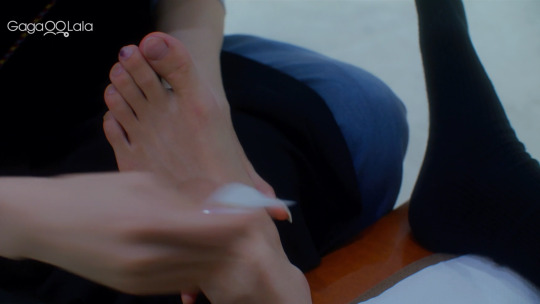
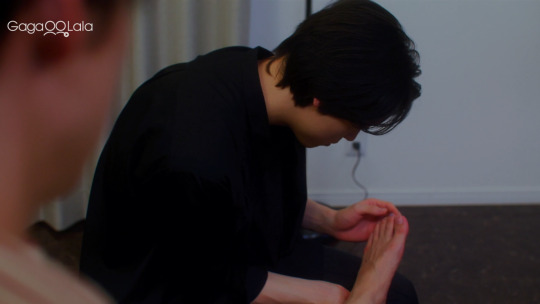
Feet are an interesting symbol. In many cultures, feet are considered dirty. To care for someone's feet is considered a sign of hospitality, respect, and even caregiving.
But even if feet are the "lowest" body part, they play an essential role. Feet take you where you want to go. For now, the feet are coming home.
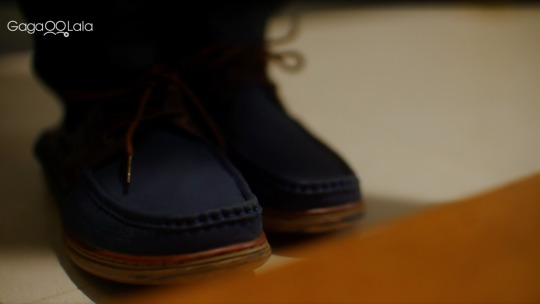
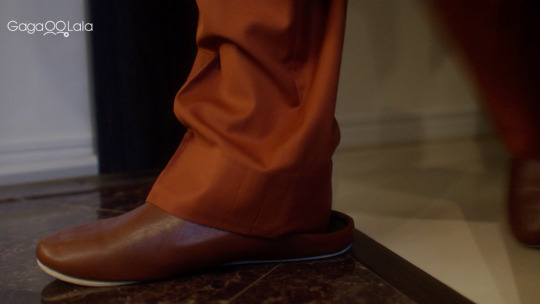
We take our toenails for granted, until they get broken. And then it's incredibly painful.
For a long time, Sei was ok in this relationship. But now he's not. The relationship is broken. But just like his toenail, his plan had been to just accept it and keep on walking. It's painful, but he'll deal.
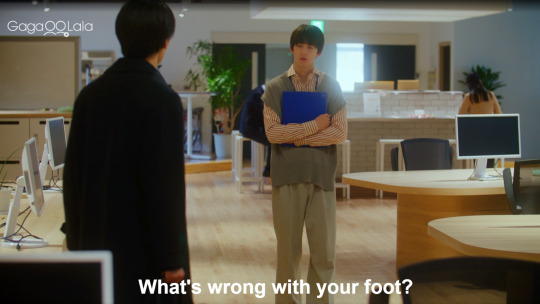
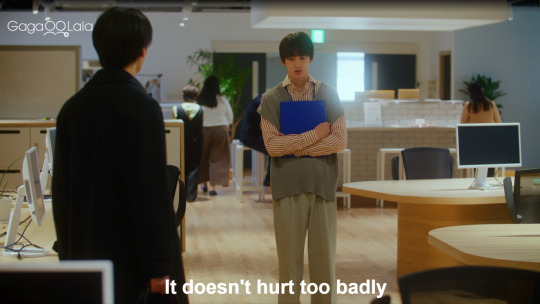
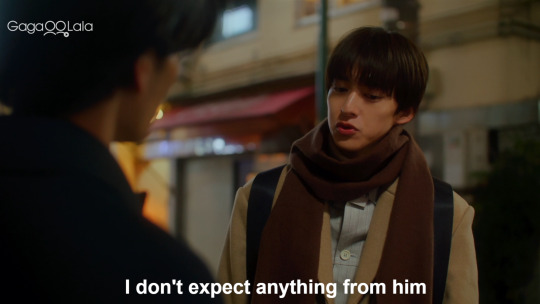
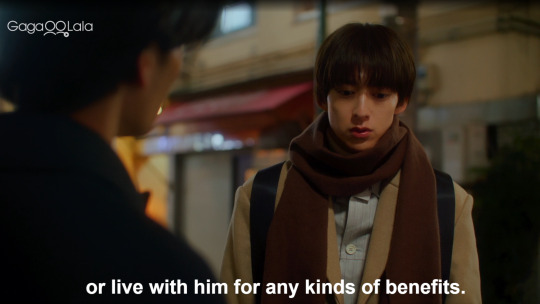
But Hagiwara won't let Sei ignore it. He keeps asking personal questions. He questions Sei about his relationship. He questions Sei about his foot. He's forcing Sei to pay attention to and deal with the broken toenail. Hagiwara openly admits (to Sei) that he wants more from his own relationship. He verbalizes his incredulity at Sei's situation.
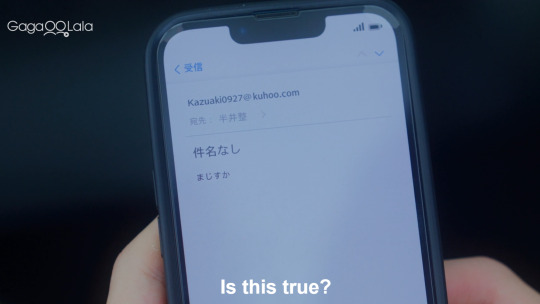
He openly states that Sei's situation is unlikely to change.
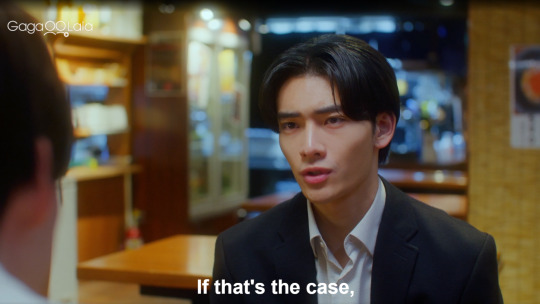
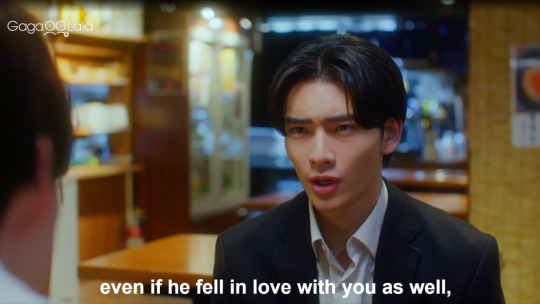
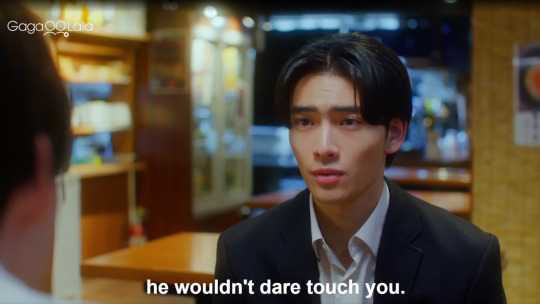
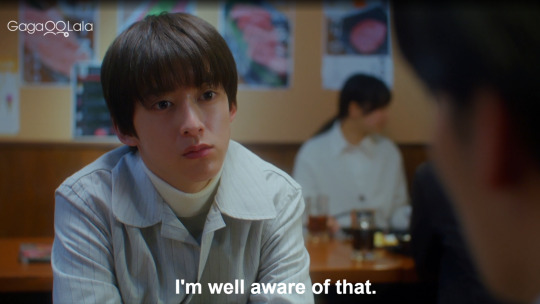
Hagiwara doesn't let Sei brush it aside. He keeps asking questions, telling Sei that it'll hurt him more if he lets it go, and pushing Sei to take action.
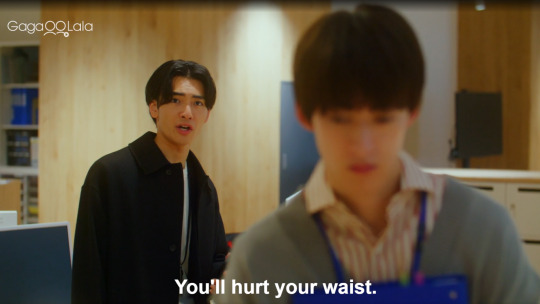
And now we have both Kaori and Fujisawa paying attention to, touching, and washing Sei's foot. Foot washing carries a lot of symbolism - of respect, of care, of sacrifice. All of the things that Fujisawa used to provide for Sei. But Sei got that help from someone else this time. He's no longer needing Fujisawa to care for him.
Kaori notices that Sei is pain. She's working on repairing the nail, but Sei still thinks she's cruel.
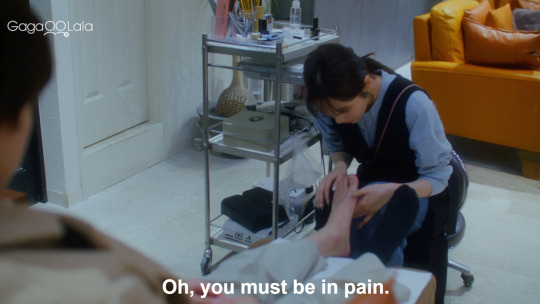
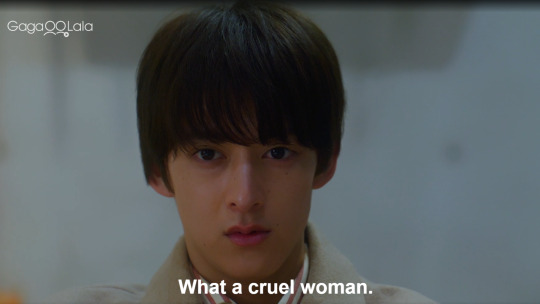
Yes, he's thinking about Hagiwara. But it parallels his relationship as well. Fujisawa KNOWS Sei is in pain. He KNOWS Sei is unhappy.
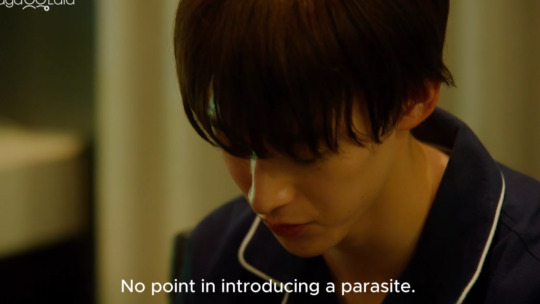
It's why Fujisawa keeps changing the conversation. It's why he buys the TV. He's trying to keep the nail/relationship from breaking further.
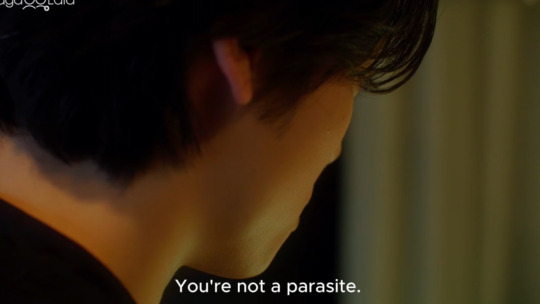
There's something to be said in that while Kaori is repairing the nail, she's also disinfecting it. The disinfectant gets mentioned by both Kaori and Fujisawa.
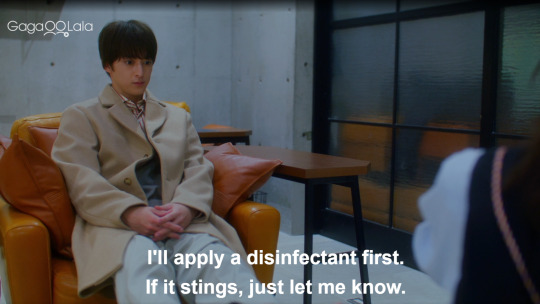
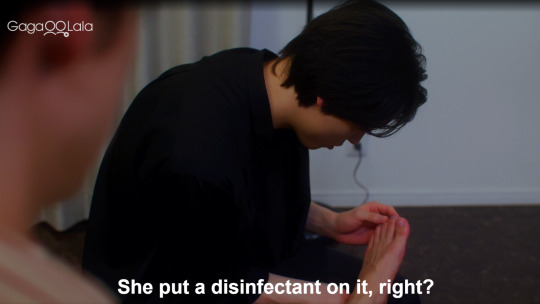
With all of the "libido is a swamp" references, it's not too far-fetched to read into this act. While Kaori and Fujisawa both care for their partners, they're both sanitizing their relationships. It stings.
But Sei doesn't want or need to be sanitized. His desires are beautiful.
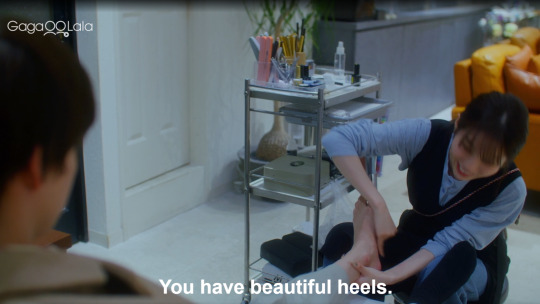
Which brings our current conflict in full view. The characters don't just want different things out of their relationships, they need different things. And everyone knows it.
Which makes me wonder about Fujisawa's comment to Sei to "not even think about meeting up" with the mystery penpal.
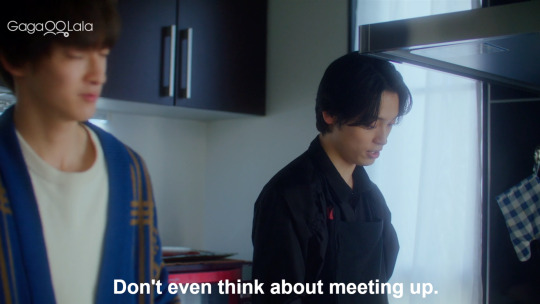
Is it jealousy? An argument could be made.
Is it possessiveness? A need to control Sei? There's a lot of evidence for that too.
Or is it that Fujisawa is also feeling the pain of this broken nail? That's he's worried just like Sei about what will happen if he pushes on it.
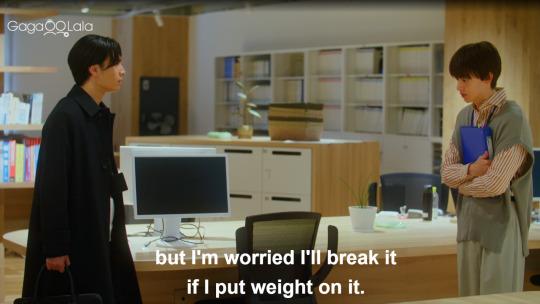
If it's no longer painful, what does that mean?
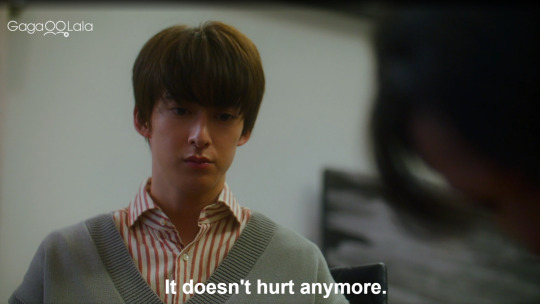
After all, he knows why Sei fell in love with him.
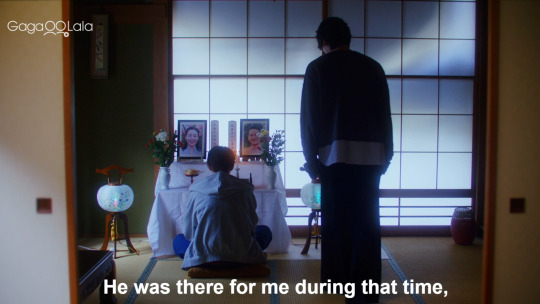
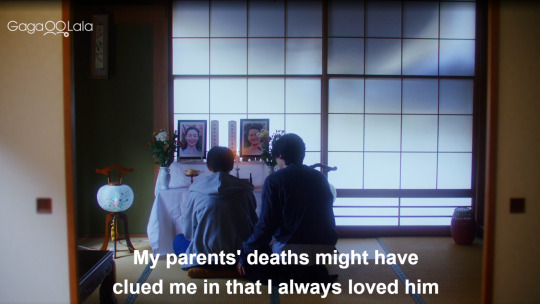
He knows that Sei no longer needs a spokesperson.
He knows that what Sei needs now, he can't give.
And he knows Sei.
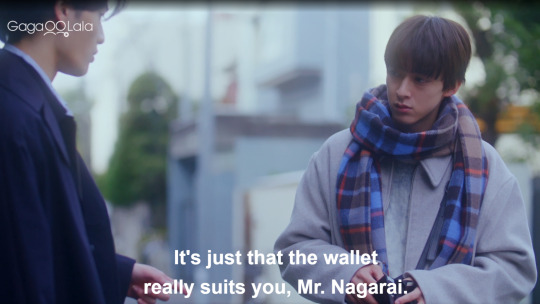
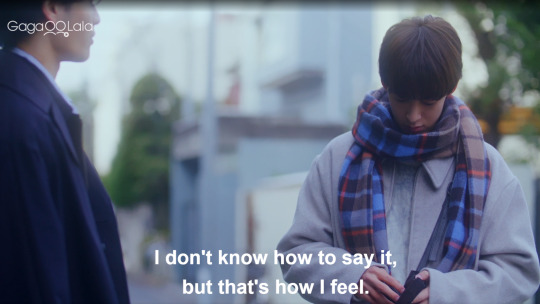
So is Fujisawa trying to control Sei? Or is he terrified of what this all means? Knowing full well what would happen to his life and relationship if someone else started meeting Sei's needs.
It's not an unwarranted fear. The feet are now moving away from home.
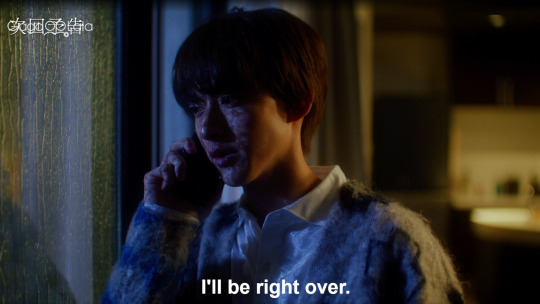

(Edit: The proofreading of this post got delayed thanks to a sick kid and the sheer number of shows that drop on Sunday. In that time, @respectthepetty made this excellent post about Fujisawa squeezing the toenail. It's a great read. Highly recommend.)
#counting down hours#i needed episode five yesterday#this post became an essay#i overthink everything#when it rains it pours#japanese bl#futtara doshaburi#my when it rains meta
125 notes
·
View notes
Text
The parallel between Buck immediately being able to fall asleep on Eddie’s couch with lights on and noises abound bc it was the one place where he felt comfortable after the lightning strike (even more so than his own home) vs him only being able to sleep there by having to distract himself with another warm body and making the place borderline unrecognizable in the dark once Eddie’s gone…. Interesting….
78 notes
·
View notes
Text
Three of my favorite things are when a show’s opening sequence tells the audience outright what’s going to happen, when sweeping thematic parallels exist between characters, and when mythological and etymological references abound. Many spoilers up to S2E6 and crack theories below because Severance does it all best.
Like many Severance theorists, I believe Gemma is in a coma or is otherwise completely brain dead. She is the Eurydice to Mark’s Orpheus. Mark is special because Gemma is special because her body and brain were well preserved. Unlike Lumon claimed, the title sequence implies that in the accident her car sunk into frozen water, a cold harbor. Because of this, her file is called Cold Harbor and she has more time than most before her body, brain, and file expire. Lumon staged her totaled car beneath the tree, burning it to hide the evidence and the removal of her actual body. Her husband, who loved her so much he choked on her ghost, consented to or was coerced by the company into splitting his own consciousness to escape her memory. Then his Innie somehow managed to make enough progress on her file to have her semi-dead body and partially reconstructed brain actively work on the Severed Floor as an almost normal wellness counselor. The opening sequence shows a car sinking under the ice of a frozen lake, and I believe it’s Gemma’s, not Cobel’s. Mark’s new focus on taking down Lumon will distract him from finishing her file, Cold Harbor, and it will expire. She will expire. Eurydice won’t walk out of the underworld because Orpheus looked back.
Then there’s Helly, the second drowning woman, a more tangible and present Eurydice who may still be lost in the end, a parallel to Gemma. The season 2 title sequence shows Helly R and Ms. Casey beneath Mark and under the water, running away from him in opposite directions. He can only follow one at a time. Helly is depicted under water in the pineapple bobbing sequence of the Lumon propaganda video and again when Irving waterboards Helena/Helly during the ORTBO. In one title sequence basement elevator shot, Gemma literally becomes Helly, all blurred into one person from Mark’s partially reintegrated perspective, just like how he sees Gemma’s face when he has sex with Helly and Helena. Their fates are tied.
The S2 opening sequence is full of babies and Helly/Helena is certainly pregnant. The last baby in the opening sequence has a Kier head, another Eagan for the family dynasty, courtesy of Mark. In the opening, Mark’s own reintegrated head morphs into a portrait of the Malice Ram typically associated with Helly, symbolizing their union in the form of a baby, and Mark watches the painting being carried away. Then the camera pans over to Gemma’s car half-sunk in the water. He can follow the Malice goat (Helly and their child) or follow his Bride of Woe (Gemma) into the lake. He can’t do both.
In S2E5 there is a faceless character (Petey? Fields?), apparently a Lumon doctor, who travels to the sub basement while whistling Gordon Lightfoot’s “The Wreck of the Edmund Fitzgerald,” a song about a real shipwreck with no survivors and how Lake Superior never gives up her dead. The Lumon painting “Kier Invites You to Drink of His Water” depicts Eagan looking out over what appears to be the Great Lakes as if he owns them. Superior—Kier—will never give up his dead. Gemma will sink under the cold water, too deep to retrieve.
But aspects of Gemma may live on. Ms. Huang, the only child in the show with a major role, is not depicted directly in the opening sequence. Other than Cobel, no Lumon employee is (unless you count Helly/Helena as one person, which should be illegal). I think Ms. Huang is likely not Mark and Gemma’s lost child, as some theories speculate. She may be a clone of Gemma, given the apparent goat cloning happening in Mammalians Nurturable, though that’s a stretch with the timeline and her age. This would be more likely if Gemma had been working for Lumon for years prior, much like Burt seems to have been involved with Lumon as early as 20 years ago despite the Severance procedure only being 12 years old. I don’t have a grand, unifying theory of Ms. Huang except to say that her surname translates from Chinese to mean yellow, gold, bright, shining, or phoenix, which is interesting when tied to Gemma. Lumon doctors could potentially take Gemma’s finished Cold Harbor file, which is stored on her Severance chip, and implant it in Ms. Huang’s brain, a true resurrection of both body and mind, exactly what Lumon needs to restore its founder, Kier Eagan.
Another interesting breadcrumb is Ms. Huang’s handheld water toy of Kier swimming with rings. It has green rings (Woe, the Bride), blue rings (Malice, the Ram), and red rings (Dread, the Crone), but no yellow rings (Frolic, the Jester). Milchick tells Ms. Huang, “You must eradicate from your essence childish folly” before truncating this statement to simply “Grow” while punishing himself for failure following his performance review. If the Gemma clone theory is true, Lumon may want Ms. Huang to mature faster (removing folly and frolic) to ensure Gemma’s adult consciousness can successfully integrate with Ms. Huang’s preteen brain. Gemma is the closest they’ve ever come to fulfilling Kier’s wishes. The phoenix has to rise again.
Now for Devon, absolute queen that she is. Mark outright calls her “Persephone” when she asks him to name her. She’s the Queen of the Underworld, the wife of Hades (Ricken, who I hope isn’t actually evil), splitting her time between the living surface and the dead world below. Devon’s a mother, she’s associated with life giving and pregnancy and caring for her little brother at the lowest point in his life. In the myth, Persephone is so moved by Orpheus’ music and plight that she convinces Hades to give him a chance to save Eurydice, as long as Orpheus doesn’t look back. I think she’ll convince Ricken to use their new “in” with Natalie, the Board, and Lumon to help Mark, however tragically it ends.
Last but never least, Harmony Cobel. The blank, glowing face staring down at a book of the grassy goat field, watching Mark and Helly heads roll around the pasture. Innie Mark carries Outie Mark into this field, illuminated by Cobel. She’s not done watching them and, quite literally, has Mark on the brain. The sequence then follows the Mark in her head to the basement elevator. I believe that Cobel is Apollo, god of light, prophecy, and music (she sings!), in the Orpheus and Eurydice analogy, a parent of Orpheus himself. This is not to say that Cobel is literally Mark and Devon’s mother, though I’d love to see that madness, but that she views Mark as her son, often mentioning her own mother when they chat. She wants Mark to thrive like Apollo wants Orpheus to thrive. Extending this comparison to the Greek gods of the Orpheus myth, you have Milchick as Hermes, the messenger god so fond of his big words, the god who travels the world (on his motorcycle), and leads souls to the Underworld. Hermes takes Eurydice back to hell when Orpheus turns around to see her one last time.
#severance spoilers#severance#mark s#mark scout#Helly r#Ms Casey#Gemma scout#Helena Eagan#kier Eagan#Seth Milchick#harmony cobel#irving bailiff#Ms Huang#Devon hale#Ricken hale#severance theory#greek mythology
122 notes
·
View notes
Text
HELLO, FRENS. Let's talk!!
Note: This is primarily for Jason fans, but some of it applies to Helena's fans, too. So pay attention. Please.
(So far I've completely avoided using the Helena tags on Tumblr out of respect, and I haven't even LOOKED because I know most of the posts from the past week would make a geiger counter scream.)
tl;dr- We FINALLY have a writer for Jason who can or might want to write him how we've been begging for all this time. Fellow fans and hyperfixaters, we must NOT fuck this up for ourselves.
Already, according to the writer's social media: "Comics people are so interesting. I've had hundreds of them ask me if I'm going to do a bad job writing these characters, like maybe I'm some kind of literary demon out to ruin their lives."
If you've been doing this, STOP. APOLOGIZE. You will METAPHORICALLY SEND FLOWERS. 🔪
Fiction is important, but real life breathing people are MORE important.
Let us be a fandom people WANT to write for.

You have fears, you have questions, doubts. You want to quiz the author on her values and knowledge. We have been burned for YEARS by writing that makes our fave look stupid and perpetuates crappy narratives. Haters abound, writers don't care about him and his fans, and now we have a new book announced that's promising us everything we've been wanting and everyone is screaming because we scared.
CHILL for a minute.
IF you reach out to the author- which you should think twice, maybe thrice about, maybe don't do it at all- you will be RESPECTFUL. You will be POLITE. You will not SPAM or FLAME or MAKE DEMANDS. You will be a MODEL FAN.

We will become THE BEST FUCKING FANDOM TO WRITE FOR, and give this writer THE MOST PLEASANT FUCKING FANDOM EXPERIENCE IN THE HISTORY OF COMIC BOOK FANDOM BULLSHIT.
You will understand that NOT EVERYONE WANTS THE SAME THING for Jason and Helena, and that is okay. We all have perfect versions of these characters in our heads. It's why we have fanfiction. Jason's fandom in particular has built several competing Platonic Ideals of Jason Todd in our heads, and we get pissed each time DC fails to approach even one of them.
But that might actually change. We might get CLOSER.
"But its pro-cop-"
The author is vocally ACAB.
"Helena deserves better she's being treated like an object-"
The author is a TRANS WOMAN who is VOCALLY FEMINIST and LEFTIST. It might be Jason's book, but this author is FAR more likely to treat her with respect than, say, fucking LOBDELL. We don't even know what Jason and Helena's relationship is going to look like. That cover might have nothing to do with it. Covers do that. I am personally down for it if it's done well, but I'm a horny bitch.
And being trans means she has been Through Some Shit, so she probably gets it. (Whys and hows of Jason and Helena's trauma.)
"The Huntress and Red Hood fandoms hate eachother-"
Grow up. What are you, 6? People like the characters they like for myriad reasons. I imprinted on Jason first, and he is a hot man, so I'm more interested in him than Helena. That doesn't mean I don't think Huntress is cool or that she doesn't deserve good books. DC has done both characters dirty, but this series might be a jumping off point for both of them.
"But my ship-"
We are not in control. I want them to make out sloppy-style after a tense, issues-long standoff. Doesn't mean I'm going to get it or that it's going to happen the way I want. Many people hate this idea. Treasure your fanfiction.
And Helena makes a lot of thematic sense for the story, regardless of romance. The two characters have interesting parallels to explore and haven't interacted much, so it's fresh ground. Having another character would mean telling a very different kind of story.
"But the helmet-"
We all love the helmet. We might even get it back one day. But not at the moment, because they're trying something different, and if losing the helmet is the price we have to pay for better writing, than so be it.
"I don't like the art-"
Bummer! Treat the artist with the same level of respect as this post demands for the writer.
"I didn't like her take on Jason in Beast World-"
We're always calling Jason "Potential Man," but with this author- and a black label- we might ACTUALLY get something good. By that I mean something that isn't made to prop up Batman and his values and make Jason look bad in comparison. Something that appears to have considerate thought put into it. She'll be somewhat bound by editorial, but she's still got WAY more leeway.
Me neither. To me he does what he does to protect the weak from experiencing what he has, not takes his day out on them. But that take might change, and if this new book starts out that way, it may not end that way. Regardless. You will be PLEASANT. If you are PLEASANT, maybe she will seek us out and LISTEN.

Lets support her.
"What if I don't like it? What if it's the same crap all over again?"
Again, you will BE POLITE. You will NOT HARASS THE CREATORS. Vote with your wallet. Write a letter. It's happened before, it will probably happen again in the future.
We will live.

I know absolutely for sure there will be features of it I probably won't like, because I am not on the editorial staff to force my opinion. It will be the same for most of us. It sucks, but at the end of the day it's still a comic book, and we'll always have fanwork.
There's a lot of crap happening out in the world right now. Don't add to it.
Peace. Be good, kids! ❤️

#jason todd#red hood#dc#huntress#helena bertinelli#only tagging because some of this applies to you guys too#forgive the intrusion Huntress Fans
31 notes
·
View notes
Text
Eventually his soulmate reincarnates as a durzagon — Tav
(durzagon are half duergar, half devil, and return to hell when they die, like Yurgir)
Tav was always told their father was a tiefling, so when they die the first time and appear back in the House of Hope, they're confused and assume it's Raphael's doing
(which, bringing them over quickly once he met, recognised, and realised what they were, was more intentional than normal — since the nautiloid passed through Avernus, their last location otherwise would be somewhere high in the sky, with no nautiloid to catch them)
Now, every time they die, they show back up in his home, and have to ask him to take them back, and all their companions get to see their sleazy situationship drop them off
One time they show up in the middle of a meeting with another devil, and Raphael is so used to hiding them protectively that he shuffles them off to the boudoir to be a more private respawn point
But durzagon are actually revered in hell, and often become leaders in whichever society they're raised in, so this is absolutely the best incarnation for their relationship to work out, as something unhidden and long-term
He just needs to convince Tav they have a desirable future ruling the hells with him
What if, uh, Raphael was soulmates with a mortal who kept reincarnating
And his '1000 concubines' of Haarlep's forms are just his soulmate's previous forms, which he revisits in between their relationships?
Or maybe he obsesses and stalks but doesn't let himself get too close, too attached, let the devils see his weakness and target you to get to him
He just lets Haarlep sleep with you and then uses Haarlep as a proxy for his emotional/sexual needs
#hmm... why does that sound familiar? 🤔😏#Once again Gortash parallels abound#raphael x tav#raphael bg3#soulmates au
26 notes
·
View notes
Note
hello my sweet. quick question: are you doing the kids easter baskets or shall i (easter in this sense is the nondenominational candy eating, egg hunt holiday). I will be saving extra cadbury eggs for us.
okay. I think we all deserve a crack fic concept this march. Imagine this: jaytim, but it’s an ides of march AU. Jason is Caesar, Tim is Mark Antony, etc. Very dramatic, right? Jason gets to die tragically, betrayed and abandoned by those he trusted (👀) Tim gets to monologue about how caesar(jason) was a just and honorable man. He takes up his mantle and cause. cinematic tragic parallels.
Except. EXCEPT. This is ACTUALLY a jaytim theater troupe AU, and the play they’re doing is none other that Shakespeare’s Julius Caesar. Jason and Tim are acting rivals in the troupe (like not enemies, but neck and neck) andJason is sooooo mad that Tim got the role of Mark Antony, because now Tim gets to deliver the Monologue™️, and Jason gets to have SO FEW lines and get stabbed. Anyways, as is tradition for theater troupes, they end up banging at the afterparty or something. (next summer the troupe does hamlet and jason and tim get cast as hamlet and horatio. the homoerotic subtext is thru the stage roof on this one.)
Hello darling, way ahead of you [pulls out the heinous carrot Easter baskets I found at Joanns' store-closing clearance sale. The walls appear to be assembled from uncannily realistic carrots. They will haunt the dreams of all who see them.]
AKKDNSA ILL ADMIT, YOU HAD ME IN THE FIRST HALF
I love this concept. I can see the opening of it perfectly, written as though the events of the play are actually happening... slapping my response under a cut because [deep sigh] it got long:
Full-on descriptions of Jason's Roman funeral and his bloodless lips that Tim sorrowfully gazes down at before he turns to the assembled people gathered around Jason's tomb. Then he opens his mouth and starts giving a speech that sounds exceedingly familiar and Shakespearean. The poetically described funeral then follows the rest of the scene line by line from the play and we start to go 'now wait a second'-- and then the audience claps as the curtains close on the scene. It was a play all alonggg
Cut to the after party. I'm making pretend that the after party is like, at the theater and not a secondary location because it's fun. Jason takes his congratulations with a charming smile, but he is definitely seething inside as he watches Tim be showered in accolades. His friends on the set see right through him (I'm thinking a mix up from the usual suspects - maybe Kon or Cassie who are also friends with Tim but became friends with Jason during production lolol and possibly Jaime or Kyle Rayner in addition) and tease and roll their eyes at him, and get him another beer.
Tim and Jason have a banter-filled conversation later in the night, at that sweet spot when the party is still going strong, the music is loud, and folks are starting to show off (stage fighting and improv'd dances abound) loose with alcohol and the triumph of a successfully wrapped production. They snipe at each other with backhanded compliments, and things are getting heated-- until the guys doing four-man floor-jousting (who the hell busted into the props room--) crash into them.
Tim gets doused in what remains of Jason's drink, Jason gets slathered in nacho cheese (neither of them were eating nachos) and their argument fizzles spectacularly as they help each other up, snickering at each other and at themselves. They walk together to their dressing room to clean up-- they both still have a change of clothes in there.
(OF COURSE THEY SHARED A DRESSING ROOM. THE BELLIGERENT SEXUAL TENSION WAS BOTH UNACKNOWLEDGED AND OFF THE CHARTS.)
As they walk, their banter smooths out-- less defensive, more genuine:
Tim: I thought I was gonna throw up on opening night, I was so nervous Jason: are you fucking for real, I thought you were trying to psych me out T: no! Watching-- uh. J: yeah? Come on. Don't leave me hanging T, sheepish: ...watching you run drills calms me down J, sputtering a laugh: flattering as that is, Drake, respectfully? That's the gayest shit I've ever heard. And we did Kinky Boots last year T, laughing as he shoves him: shut up, just forget I said it, okay? J: absolutely not, I'm gonna remember this forever.
They get to the dressing room still laughing at each other, and get changed. Only, this time, there isn't the rush of scene changes or hair and makeup, or anyone else who wants them out in ten (thank you, ten). There's nothing to distract them from each other's proximity, and everything that's been slowly boiling all season, ramping up all night, comes to a peak. One second, Tim's peeling himself out of his wet dress shirt, the next, Jason's right there, and he's looking at Tim's mouth.
"You've got," Jason says, cutting himself off to swipe a thumb over the corner of Tim's mouth, like he's just fixing his makeup, like he's done for any number of his stage partners before. Tim thinks Jason did it for him just last week. "There." Tim's mouth falls open anyway, his tongue catching against Jason's thumb. He tastes cheese dip, and the salty drag of Jason's skin. Jason pauses with Tim's face in his hands, holding Tim in place. Tim fights the urge to swallow as saliva gathers at the site of intrusion; as back and forth, Jason slowly smears his bottom lip wet. "...there," Jason says again, low and wanting. Tim leans in and kisses him.
...aaaand then they bang in the dressing room like they've low-key been wanting to do all season, glory hallelujah amen 🙏🙏🙏
(Next year as Hamlet and Horatio they keep ad libbing a Lot of touchy feely stage direction and the director does Nothing to stop them lmfao their chemistry is bonkers and it's getting butts in seats 😌)
#my wife has all the best ideas 💖#happy ides of march PSYCH actor au be upon you#🍷💥anon#jaytim#asked and answered#my writing#also lol my love i think something Happened because i received this ask about 9 times fjdsljfa
41 notes
·
View notes
Text
(Found these notes i wrote for myself the other day in my drafts, about the parallels between Robin and some HP female heroines, and given this last ask i received, i've decided it's a sign i should post them! Careful, there are some minor spoilers for Robin's past in there)
Parallels between Ginny and Robin:
Role in the story: both are the main character's love interest (though of course Robin is a main character on par with Strike, unlike Ginny who stays firmly in the secondary/support character category)
Physical: Emphasis on long shiny / bright hair. Solar metaphors abound. Both have a "natural" and unintimadating sort of beauty (not shown to be wearing a lot of make-up, described as "pretty" and "attractive" more often than "beautiful", especially in the first books of their respective series). Both get a lot of male attention, though for Robin it's in a more mature way. Both wear a green dress at the start of their LI's romantic arc (admitedly Harry doesn't yet care about Ginny that way in Goblet of Fire, but it's the book where romance in general starts to matter and Harry starts taking an interest in girls)
Familial make-up: both are countryside girls (though not the same countryside, Ginny is from south-west England, Robin si from oop North). Both are from large families and only have brothers (though only Ginny is the youngest; Robin is a middle child). Both have an over-bearing but well-meaning mother and a more subdued father with slightly eccentric interests (Muggles for Arthur and ahem "sheep management" for Mr Ellacott). Average, uncomplicated childhood experience with loving parents and a solid familial structure (as opposed to Harry/Strike's rocky childhoods).
(Sexual) trauma as backstory: [SPOILERS] an explicit version for Robin, who was raped in her early adulthood. For Ginny it's a more subtle sort of trauma, due to the Potter series being aimed at children – a possession of the mind. Still, due to Riddle comparing himself repeatedly to Harry (or Harry himself remarking that they look similar), and Ginny's innocent childish crush on Harry at this point, the subtext of sexual grooming is strong. This traumatic experience also partially allows Ginny/Robin to bond with Harry/Strike.
Personality traits: very daring, attached to their independance, especially after the aformentioned traumatic experience. Compassionate and usually chill, but capable of cold anger if they feel patronised.
Tastes/interests/career choices: Both are adrenaline seekers - Robin with driving, Ginny with flying. Both had a change of career (though for Robin it was more that she dropped out of her planned path at uni), but those careers/career plans were connected (Ginny went from Quidditch player to sports reporter, Robin from a student in psychology who considered entering the police to a private detective). Both's later careers involve investigative work. Also, both have physical, active jobs as opposed to desk jobs.
Character growth: Specifically, evolution from underling to equal. Both Ginny and Robin are younger than Harry/Strike. Obviously it's a smaller age gap for Harry and Ginny, but because they're in school, the gap is significant (they're not in the same year and don't study together). Both girls rapidly catch up to the skills of the boys and become their equals.
Trivia: Both are connected to horses - Ginny's Patronus is a horse, Robin used to ride horses as a girl and knows a great deal about them (plot relevant in the fourth Strike novel, Lethal White).
Humour/"lightness": Ginny's ability to make Harry laugh is implied to be why he falls for her more than anything else. While Robin is less of a jokester, in her absence, Strike often misses their banter and is generally gloomier.
Parallels between Robin and Tonks
(many echo the points made above but since Tonks is often unfairly passed by i thought i'd focus on her a little):
"Masculine" name: Robin is unisex, and Tonks goes by her last name (which is her father's name). Also, Robin hates her middle name Venetia, and Tonks her first name Nymphadora; both names sound very feminine in an old-fashioned sort of way. (That being said, Tonks seems to tolerate "Dora" from Remus).
Age gap: even more obvious than the one between Harry and Ginny, there's the one between Tonks and Lupin (something like 12 or 13 years), with Remus citing it as a reason they shouldn't be together, echoing some of Strike's worries and self doubt (he and Robin have a 10 years age gap).
Profession: Obviously Tonks is an Auror, the equivalent of a special investigator (not merely "a cop"), which is close to Robin's PI job. But more specifically, Tonks's speciality is disguises (has a natural ability for limited shapeshifting), which is similar to Robin's useful gift for mimmicking accents. Robin regularly disguises herself using wigs and contacts for cases.
Personality: Again, independance and the need to be treated as an equal is a big one. Tonks is furious when Lupin basically freezes her out because he thinks he's not good enough for her, and doesn't stay behind as he wished during the battle of Hogwarts in DH.
"Pretty and chill", not "femme fatale": Robin is definitely more feminine and conventional than Tonks; that being said, again, Tonks's simple prettiness is compared to another girl (this time Fleur)'s VERY intimidating and almost supernatural beauty.
"Light to his dark": Again, Tonks doesn't take herself too seriously and makes Lupin happier with her positive energy. Similar to the Harry/Ginny and Robin/Strike dynamics. Without being genki girl caricatures, all three are willing to knock some sense into their boys's heads when they get too broody and self-involved.
Good with kids: Neither Robin nor Tonks are exactly "maternal" (Robin explicitely doesn't want kids), but they are both protective of kids, particularly teenagers. All the kids in HP seem to find Tonks pretty cool (Ginny especially seems to admire her and i wish that dyamic was explored more; and she's basically Harry's inspiration for becoming an Auror). Robin is very concerned by the fate of several kids and teenagers in the Strike series, especially in books 6 and 7 - Flavia, Rachel and Zoe in TIBH, Lin Doherty and to a lesser extent Will, who is more of a young adult.
(Interestingly, this seems to be a quality that Strike appreciates in Robin; despite the fact that he's generally uncomfortable with kids (or the idea of having them), he falls out of love with Charlotte because she suggests abandonning her newborn twins so they can get back together. Obviously Lupin must appreciate the quality in Tonks as well since he likes kids (he enjoyed being a teacher and mentoring Harry), but is anxious about having them because he doesn't want to risk "passing his disease" to an innocent child. There's definitely a bit of that in Strike's reluctance to have kids too, it's implied that he thinks he wouldn't be a good father because of his own parenting models, but Strike has shown that he could be a good uncle, and teenage boys like him well enough.)
And finally,
Parallels, and contrasts! between Hermione and Robin:
Same core, diverging paths: Aside from the usual qualities in JKR's heroines (bravery, intelligence, compassion for the weak and a strong sense of Justice!, unassuming prettiness etc.), there's surprisingly little in common between Hermione and Robin! Despite both characters being clearly inspired by Jo's personal struggles in childhood/early adulthood, they manage to be quite different.
Weak spots and strong suits: Hermione is a book worm, more at ease in a library than on a broomstick, tends to freeze when stressed, and is more of a creative thinker than a duelist. Meanwhile, expert driving was what Robin used to get ouf of her own head after her traumatic rape, and she reacts quickly under pressure (like when she saved someone by jumping on train tracks). While clever, Robin didn't go back to uni after dropping out and chose to go to work instead; Hermione went back to school to finish her studies after the war. Hermione is a strongly political character with firm convictions and a desire to act on them; Robin has a more detached approach, her sense of ethics is less intellectual and more emotional. Robin is generally well-liked but underestimated, Hermione is prickly and gets on people's nerves but they generally know not to mess with her.
Romantic fumbles: A few of the comedic beats in Hermione and Ron's developping relationship are reused/continued in Strike and Robin's. For example, 15 yo Ron blindly picking a perfume for Hermione (she called it ""interesting"") is echoed by Strike wisely deciding to let Robin choose her own in Troubled Blood.
Hypercompetency: both are extremely competent sidekicks to the male hero in their respective series (see: "Robin is Everything, Strike is just Ken", "Harry wouldn't have survived without Hermione" jokes). Also, this leads to them being semi-forced into a "caretaker" role which can feel like a weight - Robin furiously calls out Strike for his behaviour after he's been forcing her to smooth over his hard edges; in DH, Hermione resents that the boys apparently let her cook because "she's the best at magic", and threatens to attack Ron when he comes back after abandonning them.
Necessary ruthlessness and social intelligence: The biggest common point by far between Hermione and Robin is their determination - once they've put their mind to something it's near impossible to pull them off tracks. Which can occasionally lead to out-of-character amorality and ruthlessness. Both women are great improvisers and can convincingly lie when necessary (Hermione: lied to McGonagall about wanting to fight the troll on her own, improvised a plan to save Luna's father in DH, convinced the Snatchers she was "Penelope Clearwater"; Robin: literally lies all the time for job reasons and regularly saves herself from being caught with quick thinking). They're also good at analysing the psychology of their foes, which helps them when they need to improvise their way out of danger: for example Hermione knows just what to say to convince Umbridge to go see Dumbledore's "secret weapon" in the Forbidden Forest. Robin manages to stall the killer in Lethal White by getting them to talk.
22 notes
·
View notes